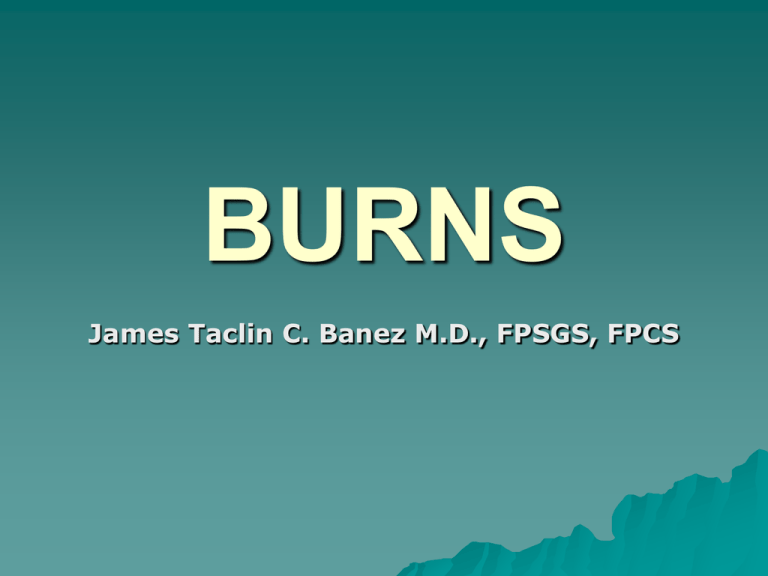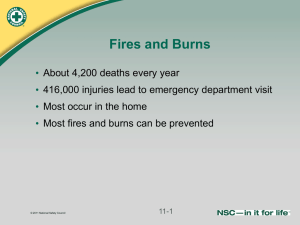
BURNS
James Taclin C. Banez M.D., FPSGS, FPCS
Etiology
Cutaneous burns caused by
application of:
1.
2.
3.
4.
Heat
Cold
Caustic chemical
Electricity
Depth of injury is proportional to:
1. Temperature applied
2. Duration of contact
3. Thickness of skin
Etiology
1.
Scald Burns:
Caused by hot water (most common
burn in civilian practice)
140F (60C) ---> deep partial of full
thickness burns in 3 secs.
Exposed areas of skin burned less than
clothed areas
Children and elderly has thinner skin
Immersion has longer contact
Scald burns from grease or hot oil are
deep burns (400F/200C).
Etiology
2.
Flame Burns:
3.
Flash Burns:
4.
2nd most common mechanism of
thermal injury. (house fire).
explosion of natural gas (petroleum)
clothing, unless it ignites, is protective
typically epidermal or partial thickness
Contact Burns:
Hot metals, plastic, glass or hot coals
Industrial accidents, motor vehicle
Are often 4th degree burns.
BURN SEVERITY
Severity is related to:
1. Burn size
2. Burn depth
3. Part of the body burned
Burn Size:
rule of 9 for adults
For children: Lund-Browder
burn chart
child assumes adult once
reach adolescence
Burn Depth:
Determinant of
mortality and longterm appearance and
functional outcome.
Burns leaving a part of
the dermis leaves
behind epithelium
lined skin appendages
Epithelial cells swarm
from the surface of
each appendages to
meet adjacent
swarming cells
The thickness of skin varies with age,
sex and area of the body:
Epidermis is thickest (0.5cm) on palm &
sole
Dermis varies from 1mm on the eyelids
and genitalia to more than 5mm at the
back.
Dermal atrophy >50y/o and skin
appendages are less active.
Burn depth is dependent on:
1. Temperature of the burn source
2. Thickness of the skin
3. Duration of contact
4. Heat-dissipating capability of the
skin (blood flow).
Classification of Burn According
to Increasing Depth
A.
Shallow Burns:
1.
Epidermal Burn:
(1st degree)
No blister
Erythema due to
dermal vasodilation
Quite painful
4th day injured
epithelium
desquamate –
peeling (sunburn)
Classification of Burn According
to Increasing Depth
A.
Shallow Burns:
Superficial Partial-thickness:
2.
Second degree
Includes upper layer of dermis
Characteristically forms
blisters (fluid accumulation
between epidermis and
dermis).
If blisters are removed the
wound is pink, wet, painful and
blanch w/ pressure
Heal spontaneously < 3wks
w/o functional impairment
Rarely cause hypertrophic
scarring, but never completely
match color of surrounding
normal skin
Classification of Burn According
to Increasing Depth
B.
Deep Burns:
Deep Partial Thickness: (second
degree)
1.
Extends into the reticular layer of
the dermis
w/ blisters but wound surface
mottled pink and white color
Complains of discomfort rather
than pain
Pressure applied --> capillary refill
is slow or absent.
2nd day wound is white and dry
If not excised & grafted heals in 3
to 9 wks w/ scarring
Joint function can be impaired
Classification of Burn According
to Increasing Depth
B.
Deep Burns:
2.
Full Thickness: (third degree)
All layers of the dermis
Appear white, cherry red or black and may or may not
have deep blisters
Leathery, firm and depressed compared w/ adjoining
normal skin
Insensate
Develop a classic burn eschar, an intact dead and
denatured dermis that separates after days or wks.
Heal only by wound contracture, epithelialization from
the wound margin or skin grafting
Classification of Burn According
to Increasing Depth
B.
Deep Burns:
3.
Fourth Degree:
Involves also the subcutaneous fat and
deeper structures
Almost always have charred appearance
Electrical burns, contact burns, immersion
burns and patients who are unconscious at
time of burn
Those that will heal w/in 3wks are
better treated by nonoperative
wound care:
Shallow burns
State-of-the-art burn care involves
early excision and grafting (E&G)
of all burns that will not heal w/in
3wks:
Deep burns
Assessment of Burn Depth
Standard technique for determining burn
depth: clinical observation of the
wound
Other techniques to qualify burn depth:
1. Ability to detect dead cells or denatured
collagen (biopsy, ultrasound, vital dyes)
2. Assessment of changes in blood flow
(fluorometry, laser doppler & thermography)
3. Analysis of the color of the wound (light
reflectance methods)
4. Evaluation physical changes, such as edema
(MRI)
Physiologic Response to Burn Injury
Burn – inflammatory process
involving the entire organism
Systemic Inflammatory Response
Syndrome (SIRS):
Alterations
of the metabolic,
cardiovascular, gastrointestinal and
coagulation systems
Resulting to hypermetabolism, increased
cellular, endothelial and epithelial
permeability
Often extensive microthrombosis
Physiologic Response to Burn Injury
Burn Shock:
Complex process of circulatory and
microcirculatory dysfunction that is not easily
or fully repaired by fluid resuscitation.
Tissue trauma & hypovolemic shock releases
local & systemic mediators ---> increase
vascular permeability and microvascular
hydrostatic pressure --->burn edema.
1.
Histamine – causes increased vascular permeability
by disrupting venular endothelial tight junction-->
egress of fluids and proteins
2.
Released by masts cells in burned skin
Serotinin – increases vascular resistance amplifying
vascular effects of NE, histamine, angiotensin II
Physiologic Response to Burn Injury
Burn Shock:
3.
Eicosanoids – vasoactive products of
arachidonic acid metabolism
4.
Released in burn tissue; produced edema
Increases the level of Prostaglandin causing
vasodilatation leading to increase bld flow and
hydrostatic pressure ---> edema
Kinins (bradykinins) – inc. premeability
There is hypercoagulable and
hyperfibrinolytic state
Pathophysiology of Burn Shock:
A. Hypovolemic etiology:
−
−
−
−
Decreased cardiac output
Increased extracellular fluids
Decreased plasma volume
Oliguria
In burn shock, resuscitation is
complicated by obligatory burn edema
Maximal edema formations occurs
between: - 8-12hrs in small burns
- 12-24hrs in major burns
Pathophysiology of Burn
Shock:
B. Changes in cellular level:
−
−
>30% burn; cell transmembrane potential
----> Na-K ATPase
Due to defective ATP metabolism
Physiologic Response to Burn Injury
Metabolic Response to Burn Injury
A. Hypermetabolism:
> 100% REE (1.3x BMR) due to:
1.
Increased heat loss from the burn wounds
2.
Due to increased blood flow and skin loss
Increased beta-adrenergic stimulation
Increased catabolism of CHO, Lipids and
CHON
Neuroendocrine Response:
B.
Catecholamine massively elevated and major
endocrine mediator of hypermetabolism in
burn
Giving propranolol – diminish REE and O2
consumption
Emergency Care
Care at the scene:
A.
Airway:
–
–
–
CPR
100% O2 via a nonrebreather mask if there is
any suspicion of smoke inhalation
If unconscious or in respiratory distress ---->
endotracheal intubation
Care at the scene:
B.
Other injuries and transport:
– assess other injuries; transport to
nearest hospital
– kept flat and warm and wrapped in
clean sheet and blanket, NPO
– IVF = lactated Ringer’s sol. at rate of
1liter/hr. in case of severe burns
– Constricting clothing and jewelry shd
be removed from burned parts due to
local swelling begins
Care at the scene:
B.
Other injuries and transport:
– assess other injuries; transport to
nearest hospital
– kept flat and warm and wrapped in
clean sheet and blanket, NPO
– IVF = lactated Ringer’s sol. at rate of
1liter/hr. in case of severe burns
– Constricting clothing and jewelry shd
be removed from burned parts due to
local swelling begins
Care at the scene:
C.
Cold Application:
– Cooling cannot reduce skin
temperature enough to prevent further
tissue damage
– Cooling delays edema formation by
reducing initial thromboxane
production
– Ice or cold water:
Never be used for it can lead to systemic
hypothermia and associated cutaneous
vasoconstriction can extend thermal
damage
Emergency Care
Emergency Room Care:
Primary rule for emergency
physician is to ignore the burn
ABC: Search for other lifethreatening injuries
Emergency Room Care:
1.
Emergency assessment of inhalation
injury:
– Suspected in flame burns or anyone
burned in an enclosed space
– Rescuers are the most important
historians
– Signs of potentially serious airway injury
a.
b.
Hoarseness & expiratory wheezes
Copious mucus production and carbonaceous
sputum
Emergency Room Care:
1.
Emergency assessment of inhalation
injury:
– Decreased P:F ratio (Pao2:FIO2), is one
of the earliest indicators of smoke
inhalation.
400-500 is normal
< 300 = impending pulmonary problem
< 250 = indication for endotracheal
intubation
– Fiberoptic bronchoscopy – can accurately
assess edema of upper airway.
Emergency Room Care:
2.
Fluid Resuscitation:
–
–
IV LR 1L/hr in adult
20ml/kg/hr in children
Foley catheter – UO/hr.:
–
After ascertaining the extent of the burn
estimate the fluid needs:
–
–
30ml/hr in adults
1ml/kg/hr in children
Parkland formula: 4ml/kg/%burn (LR)
Modified Brooke: 2ml/kg/%burn (LR)
<50% TBSA use 2 large bore IV line
>50% or other medical problems CVP
>65% TBSA--> burn center
Use upper extremities as portals for IV
Other formulas estimating adult
burn pt resuscitation fluid needs:
Use colloid formulas:
1. Evans:
– NSS
1ml/kg/%burn
– 1ml/kg/%burn
– 2000ml D5W
2. Brooke:
– LR
1.5ml/kg/%bur
n
– 0.5ml/kg
– 2000ml D5W
3.
Slater:
– LR 2L/24h
– Fresh frozen
plasma
75ml/kg/24hr
Colloid generates
inward oncotic
force to
counteracts
outward
intravascular
hydrostatic force.
Emergency Room Care:
3.
4.
Tetanus prophylaxis: active/passive
Gastric decompression: NGT
– enteral feeding ---> reduce Curling
ulcers, prevents ileus and blunt
catabolism
5.
6.
Pain control: IV opiates
Psychosocial care
Care of Burn Wound:
–
In transferring a pt, wound is minimally
dressed in gauze; pulses distal to
circumferential deep burns should be
monitored
– Escharotomy:
Edema formation--> vascular compromise--->permanent neuromuscular & vascular
deficits.
– Skin color, sensation, capillary refill and
peripheral pulses assessed hourly
S/Sx warrants escharotomy:
1.
2.
3.
4.
5.
Cyanosis
Deep tissue pain
Progressive paresthesia
Progressive decrease or absence of pulses
Sensation of cold extremities
Respiratory distress
due to deep
circumferential burn
wound of the thorax
Local anesthesia is not
needed; but IV opiates
or anxiolytics is given.
INHALATION
INJURY
1.
Carbon Monoxide Poisoning:
– Majority of house fire deaths
– CO2 is colorless, odorless and tasteless
gas w/ affinity to Hgb 200x that of 02.
– Mechanisms of interfering O2 delivery:
a.
b.
c.
d.
e.
Prevents reversible displacement of O2 on
the Hgb molecule
COHg shifts the O2-Hg dissociation curve
to the left.
CO2 binds to reduced cytochrome a3,
causing less effective intracellular
respiration
CO bind to cardiac and skeletal muscle,
direct toxicity
CO act in CNS causing demyelination
causing neurologic symptoms.
1.
Carbon Monoxide Poisoning:
– Symptoms:
a.
b.
c.
Headache, N/V, loss of manual dexterity
Weak, confused and lethargic
Coma
− CO reversibly bound to the heme:
−
−
−
−
Room temp = half-life (t1/2) of COHb is 4hrs
100% O2 = t1/2 is reduced to 45-60mins
Hyperbaric O2 at 2atm. = t1/2 30mins
Hyperbaric )2 at 3atm. = t1/2 15-20min
− Tx: 100% oxygen via a nonbreather
face mask
2.
Thermal Airway Injury:
– Most of the heat in burning room is
dissipated in the oropharynx,
nasopharynx and proximal
tracheobronchial tree due to:
a.
b.
Oropharynx and nasopharynx provide an
effective mechanism of heat exchange due
to:- large surface area
- associated air turbulence
- mucosal fluid lining that acts as a heat
reservoir.
Sudden exposure to hot air typically
triggers reflex closure of the vocal cords
2.
Thermal Airway Injury:
– Greatest risk:
a.
b.
c.
Explosion
Burns of face and upper thorax
Unconscious in a fire
− Edema ---> upper airway obstruction
− Presence of intraoral and pharyngeal
burns indication ---> endotracheal
intubation
− Tube is placed until edema subsides
− Steroid has no role in tx upper airway
edema in burns.
3.
Smoke Inhalation:
–
Wheezing and air hunger early manifestations
of inhalation injury:
Classical findings in pulmonary function test:
1.
2.
3.
4.
5.
Product of combustion (hydrogen cyanide)
Decreased functional residual capacity
Decreased vital capacity
Evidence of obstructive disease w/ reduction in flow
rates
Increase in dead space
Rapid decrease in compliance
Concomitant cutaneous burn releases mediators
(Prostaglandin, thromboxane, and reactive O2
intermediates) that can aggravate pulmonary
injry.
w/o associated cutaneous injury, mortality from
isolated inhalation injury is quite low.
Diagnosis:
1.
2.
3.
4.
5.
6.
7.
8.
Anyone w/ flame burn sustained in an enclosed
space is assumed to have inhalation injury until
proven otherwise.
Hoarseness, stridor, edema or soot impaction
Chest auscultation for wheezing or rhonchi
suggesting injury to distal airway
Level of consciousness associated w/ decreased
w/ hypoxia, CO poisoning or cyanide poisoning
Testing for the presence of neurologic deficits
associated w/ CO.
Copious mucus production and carbonaceous
expectorated sputum
Al elevated COHb or any symptoms of CO
poisoning are presumptive evidence of
associated smoke inhalation
Earliest indication of smoke injury is decreased
P:F ratio.
Routine use of fiberoptic bronchoscopy
Treatment:
A. Upper Airway:
– Rapid endotracheal intubation due to
oropharyngeal/laryngeal edema.
– Ability of adult pt to breathe around
the tube w/ the cuff deflated is an
indication for tube removal.
– Tx of postextubation stridor:
Administration of nebulized racemic
epinephrine and helium-oxygen mixtures
Steroids are never used.
Treatment:
B. Lower Airway and alveoli:
– Overall treatment for smoke inhalation
is supportive w/ the goal being
maintenance of adequate oxygenation
and ventilation until the lungs heal.
– Mild cases are treated w/ humidified
O2, vigorous pulmonary toilet, and
bronchodilators as needed.
– If w/ atelectasis, positive endexpiratory pressure is useful to
increase FRC, increasing oxygenation.
Treatment:
B. Lower Airway and alveoli:
–
–
–
–
High frequency percussive ventilation (HFPV)
provide superior oxygenation at a lower FIO2,
w/ lower airway pressures than conventional
mechanical ventilation. This enhanced
clearance of bronchial secretions
Cricothyroidotomy for danger imminent
obstruction and unsuccessful endotracheal
intubation. This is later converted to
tracheostomy
Prophylactic antibiotics are indicated w/
inhhalation injury, which is a chemical
pneumonitis.
Steroids are contraindicated due to septic
complications and higher mortality rate
WOUND
MANAGEMENT
Shallow burns healed w/in 3 wks while
deep burns healed over many weeks if
infection was prevented
For deeper wounds rather waiting for
spontaneous separation, the eschar is
surgically removed and closed via grafting
techniques and/or immediate flap
procedures (E&G)
Early E&G has reduced burn mortality
more than any other intervention. It
decreases the number of painful
debridements required.
Immunosuppression and hypermetabolism
associated w/ burns is ameliorated
NOTE:
His
notes only cover up to page 204
in schwartz.
READ!!! Pg. 205-217
Good luck









